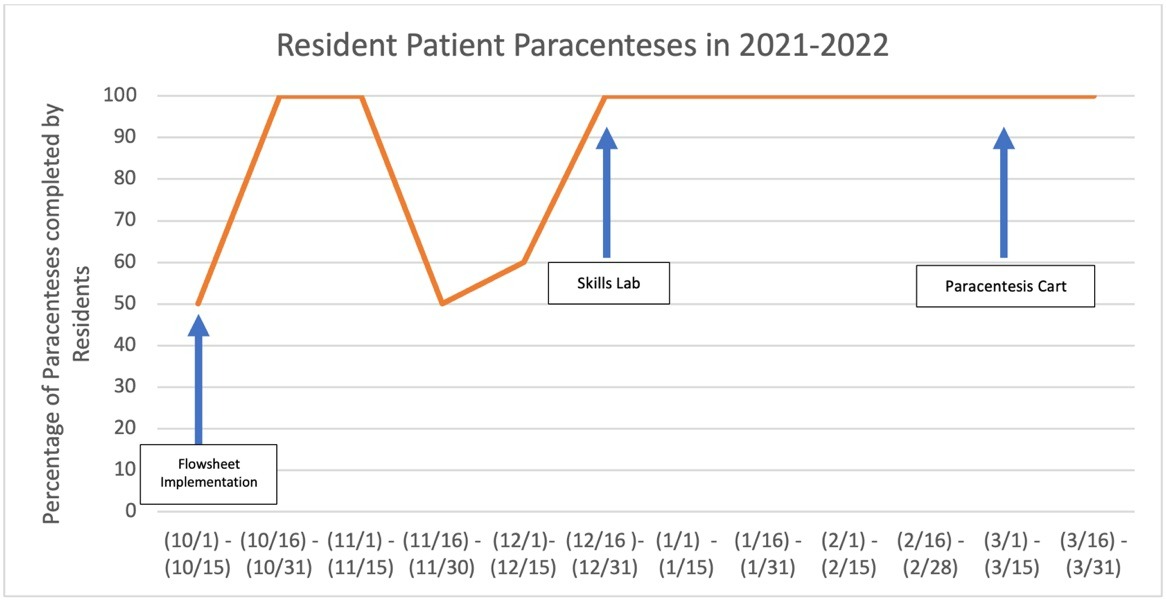Back
Poster Session D - Tuesday Morning
D0514 - Improving Procedural Graduate Medical Education for Internal Medicine Residents: Increasing Resident Participation and Comfort with Bedside Paracentesis
Tuesday, October 25, 2022
10:00 AM – 12:00 PM ET
Location: Crown Ballroom
.jpg)
Michael Harring, MD
Inova Fairfax Hospital
Falls Church, VA
Presenting Author(s)
Michael Harring, MD, Narotham Badrish, MD, Patrick Brown, MD, Reem Al Shabeeb, MD, Jin-ju Kim, MD, Dipam Shah, MD
Inova Fairfax Hospital, Falls Church, VA
Introduction: Graduate medical education has been seeking to improve procedural education for internal medicine residents for many years. There has been a decline in the number of procedures performed and the comfort level for internal medicine residents and hospitalists over the past 30 years, with the American Board for Internal Medicine no longer requires procedural competency. At Inova Fairfax Medical Campus, bedside procedures are often outsourced to other non-resident procedure teams, especially advanced practice providers. Evidence suggests more procedural experience is associated with reduced complications and increased procedural competency.
Methods: Data from paracenteses performed by both medical residents and advanced practice providers (APP) were analyzed using chart review and online data gathering tools from October to March to determine the number of procedures performed on resident patients by APP’s. Interventions included a procedure workshop and introduction of a paracentesis cart with data analyzed before and after interventions.
Results: Using the online data gathering tools, we successfully collected data on all paracenteses performed on resident patients between October and March in the current and previous academic year. In the 6-month period and with each PDSA cycle, there was in increase in the percentage of paracenteses for resident patients performed by residents. After our first PDSA cycle of flowsheet implementation, there was still fluctuation in the percentage of paracenteses. However, after the skills session and finally the implementation of the paracentesis cart, we have shown a consistent 100 percent rate of paracenteses completed by residents. Compared to the prior year, there was more consistency in achieving a high percentage of resident completed paracenteses.
Discussion: Residency is an important step in a physician’s training and for internal medicine residents, becoming adept in certain procedures is a skill that can be utilized for the rest of their professional careers. By utilizing a simplified flowsheet, as well as introducing a paracentesis cart and providing skills training workshops, we have successfully increased the percentage of resident-performed paracenteses. Further steps may include creating a specific resident-run procedure team, as well as flowsheet/training for other bedside procedures including central lines, thoracentesis, and lumbar punctures.

Disclosures:
Michael Harring, MD, Narotham Badrish, MD, Patrick Brown, MD, Reem Al Shabeeb, MD, Jin-ju Kim, MD, Dipam Shah, MD. D0514 - Improving Procedural Graduate Medical Education for Internal Medicine Residents: Increasing Resident Participation and Comfort with Bedside Paracentesis, ACG 2022 Annual Scientific Meeting Abstracts. Charlotte, NC: American College of Gastroenterology.
Inova Fairfax Hospital, Falls Church, VA
Introduction: Graduate medical education has been seeking to improve procedural education for internal medicine residents for many years. There has been a decline in the number of procedures performed and the comfort level for internal medicine residents and hospitalists over the past 30 years, with the American Board for Internal Medicine no longer requires procedural competency. At Inova Fairfax Medical Campus, bedside procedures are often outsourced to other non-resident procedure teams, especially advanced practice providers. Evidence suggests more procedural experience is associated with reduced complications and increased procedural competency.
Methods: Data from paracenteses performed by both medical residents and advanced practice providers (APP) were analyzed using chart review and online data gathering tools from October to March to determine the number of procedures performed on resident patients by APP’s. Interventions included a procedure workshop and introduction of a paracentesis cart with data analyzed before and after interventions.
Results: Using the online data gathering tools, we successfully collected data on all paracenteses performed on resident patients between October and March in the current and previous academic year. In the 6-month period and with each PDSA cycle, there was in increase in the percentage of paracenteses for resident patients performed by residents. After our first PDSA cycle of flowsheet implementation, there was still fluctuation in the percentage of paracenteses. However, after the skills session and finally the implementation of the paracentesis cart, we have shown a consistent 100 percent rate of paracenteses completed by residents. Compared to the prior year, there was more consistency in achieving a high percentage of resident completed paracenteses.
Discussion: Residency is an important step in a physician’s training and for internal medicine residents, becoming adept in certain procedures is a skill that can be utilized for the rest of their professional careers. By utilizing a simplified flowsheet, as well as introducing a paracentesis cart and providing skills training workshops, we have successfully increased the percentage of resident-performed paracenteses. Further steps may include creating a specific resident-run procedure team, as well as flowsheet/training for other bedside procedures including central lines, thoracentesis, and lumbar punctures.

Figure: Timeline of interventions during analyzed period for resident performed paracenteses
Disclosures:
Michael Harring indicated no relevant financial relationships.
Narotham Badrish indicated no relevant financial relationships.
Patrick Brown indicated no relevant financial relationships.
Reem Al Shabeeb indicated no relevant financial relationships.
Jin-ju Kim indicated no relevant financial relationships.
Dipam Shah indicated no relevant financial relationships.
Michael Harring, MD, Narotham Badrish, MD, Patrick Brown, MD, Reem Al Shabeeb, MD, Jin-ju Kim, MD, Dipam Shah, MD. D0514 - Improving Procedural Graduate Medical Education for Internal Medicine Residents: Increasing Resident Participation and Comfort with Bedside Paracentesis, ACG 2022 Annual Scientific Meeting Abstracts. Charlotte, NC: American College of Gastroenterology.
